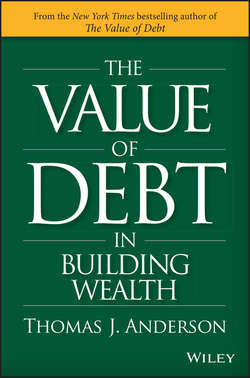Читать книгу The Value of Debt in Building Wealth - Thomas J. Anderson - Страница 13
На сайте Литреса книга снята с продажи.
Chapter 1
The Traditional Glide Path
The Power of Savings
ОглавлениеWe need to frame questions about debt, savings, and balance against the fact that compounding matters to long-term investment returns. Table 1.1 shows that to retire with $1 million, you can choose to save any of the following:
● $360 a month at age 20 (with a total of $194,400 saved and invested);
● $700 a month at age 30 (with a total of $294,000 saved and invested);
● $1,435 at age 40 (with a total of $430,500 saved and invested);
● $3,421 at age 50 (with a total of $615,780 saved and invested); or
● $14,261 at age 60 (with a total of $855,660 saved and invested).
Table 1.1 Summary of Savings Rate to Accumulate $1 million by 65
Assuming a 6-percent rate of return, each of these approaches yields $1 million at age 65. But what's particularly interesting is the person who starts at 20 invests $194,400, or about 77 percent less than the person who starts saving at 60 and invests $855,660. This is the difference compounding makes. And I believe we are so anxious to pay down debt that it can come at a cost of deferring our long-term savings and that this cost is significant when we finally direct money to savings. We do not give our money time to grow for us.
THE DIFFERENCE COMPOUNDING MAKES
Jennifer and Josh are both savers and investors. Jennifer starts saving and investing at age 20 and saves $2,000 a year until she's 29 – a total of $20,000. Josh starts saving and investing the same amount, $2,000 a year, when he's 30 and does so until he's 65 – a total of $70,000. They both invest in a diversified portfolio of equities and receive an average 8-percent return over the entire period of time that their money is invested. Who will have more money in retirement at age 65?
At age 65, Jennifer will have about $463,000; Josh will have about $375,000 – $88,000 less. This is because Jennifer reaped the benefits of earlier compounding.
Starting early makes an enormous difference!12
12
The case studies presented are for educational and illustrative purposes only and cannot guarantee that the reader will achieve similar results. Your results may vary significantly and factors such as the market, personal effort, and many others will cause results to vary. All of the case studies throughout the book are hypothetical and not intended to demonstrate the performance of any specific security, product, or investment strategy. Opinions formulated by the author are intended to stimulate discussion.
